In India, the concept of matching the kundli, or birth charts, of a prospective bride and groom before arranging a marriage is widely practiced. This ancient ritual holds great significance, particularly within the Hindu, Sikh, and Jain communities. But what is the reasoning behind Kundli’s matching? Why do people engage in this practice before finalizing a marriage?
It is believed that by matching the Kundli of the two individuals, the longevity of their marriage can be predicted. This ritual serves as a means of assessing compatibility between the prospective bride and groom. In the past, this practice was considered essential for a successful union. As a result of such practices, it may surprise you to learn that India has one of the lowest divorce rates in the world. In fact, according to statistics provided by the United Nations Department of Economic and Social Affairs, India stands at the forefront in terms of a low divorce rate globally.
The United Nations Department of Economic and Social Affairs has compiled data on worldwide marriages and divorces spanning from 1960 to 2017.
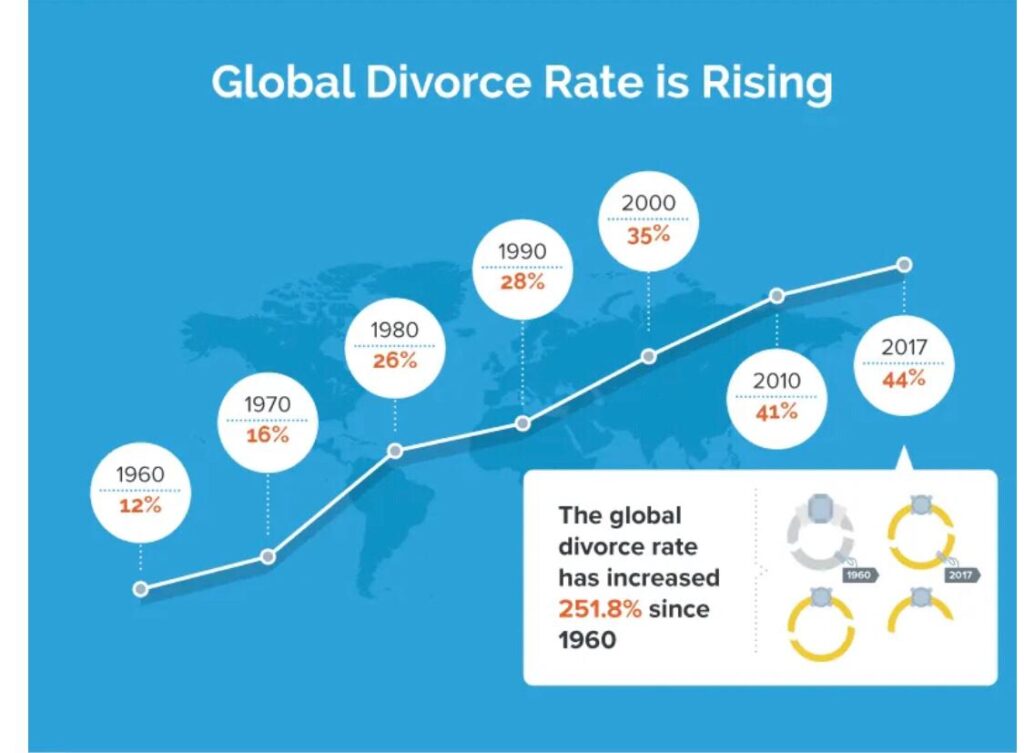
It is evident from their findings that divorce rates have been steadily increasing on a global scale. By examining these statistics, we observe an alarming rise of 251.8% in divorce rates since 1960.
Furthermore, upon breaking down the data by country, we can identify the ten nations with the highest divorce rates, as well as the ten countries boasting the lowest divorce rates.
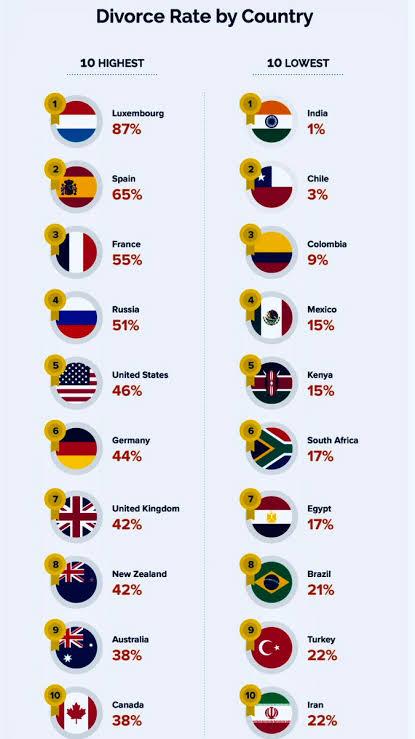
The list above reveals striking numbers regarding divorce rates in various countries. At the forefront is Luxembourg with a staggering 87% divorce rate, occupying the topmost position. Russia follows closely in fourth place, boasting a 51% divorce rate, while the United States takes fifth place with a 46% divorce rate. Meanwhile, Canada secures the tenth spot with a 36% divorce rate. However, when it comes to the countries with the lowest divorce rates, India triumphantly claims the first position with an astonishingly low divorce rate of 1%, making it the leader in this aspect across the globe.
Given India’s rich religious diversity, the Indian government has published data on divorce rates based on different religions between 2001 and 2011. This data specifically identifies women who live separately from their husbands and those who have undergone divorce during this specified period. By examining this published information, it becomes evident that the Hindu religion exhibits the lowest divorce rate at 2.2%. Following closely behind is the Sikh religion, sharing the same divorce rate of 2.2% as Hinduism. The Jain religion ranks third, displaying a divorce rate of 2.7%. Take a moment to peruse the data that has been officially released by the Indian government.
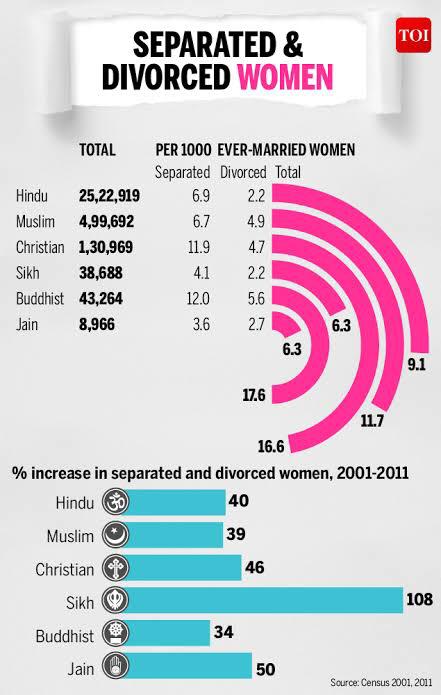
Source TOI
The practice of Kundli matching is primarily observed among followers of the Hindu and Jain religions in India. Analyzing the aforementioned statistics, it becomes evident that India boasts the lowest divorce rate. Furthermore, within India, the religions of Hinduism, Sikhism, and Jainism also exhibit the lowest rates of divorce and separation. While there may be various factors contributing to this phenomenon, Kundli matching holds considerable significance in maintaining the low divorce rate.
Unfortunately, the influence of Western culture on our beloved country, India, has diminished the importance of this ancient ritual. As a result, many prospective partners are no longer engaging in Kundli matching. Consequently, divorce rates in India have gradually increased over time, posing a challenge to the long-standing tradition and its effectiveness.
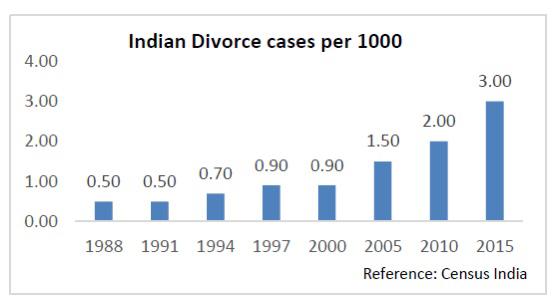
The data provided by the Government of India, spanning from 1988 to 2015, reveals a significant and rapid increase in divorce rates since the year 2005. Throughout my encounters, I have come across two distinct groups of individuals with contrasting views. The first group comprises those who possess a genuine curiosity to grasp the importance behind Kundli matching, while the second group consists of deeply religious individuals who dismiss the concept altogether. Drawing insights from the aforementioned data, it becomes evident that by matching Kundli prior to marriage, the likelihood of divorce decreases. However, religiously inclined individuals argue that faith in God supersedes the need for Kundli matching, deeming it a futile practice.
It is essential to comprehend that matching birth charts before marriage, akin to acquiring driving skills or seeking medical treatment, serves as a preventive measure to avert any potential mishaps in one’s married life. Furthermore, it is crucial to acknowledge that the same God who created the vast universe also bestowed upon us the sacred Vedas, within which astrology holds its place.
In recent times, the prevalence of love marriages has grown significantly, leading to a significant decline in the practice of Kundli matching. It is observable that even in love marriages, the initial connection between the two individuals often fades away over a relatively short span of time. This disconnection can be attributed to the presence of inherent incompatibilities between the partners. To determine the compatibility between a couple, astrological calculations are performed by studying their respective Kundli. By comparing and analyzing the Kundli of prospective partners, we can gauge whether they will remain loyal to each other if their mutual affection will endure, and other pertinent aspects. Additionally, a comprehensive examination encompassing physical, mental, emotional, and spiritual aspects is conducted while matching the birth chart, allowing us to gain insight into the potential course of our married life. Consequently, marriages, where the birth charts are aligned, tend to endure longer within the Indian cultural context compared to those where such alignment is absent.
According to the principles of Indian Astrology, there are three types of birth chart matching. First is Nakshatra Melapak, also known as ‘Ashtakoot Melapak’ or ‘Gunank’. The second is ‘Graha Melapak’, while the third is ‘Bhaav Melapak’.
In the realm of Ashtakoot Melapak, the focus lies on the comparison of 36 qualities within your kundli and the kundli of your potential partner, determined by the alignment of both nakshatras. Through a calculation of the Guna match within these nakshatras, the strength of your compatibility is assessed. The aid of Gunank allows you to determine whether your match with your prospective partner is strong, average, or weak.
In Graha Melapak, we delve into the analysis of different doshas within the kundli, such as Mangal Dosh, Shani Dosh, Rahu Dosh, and Ketu Dosh. Additionally, we consider the positions of Jupiter and Venus. Although all planetary aspects are taken into account, Mangal Dosh carries more weight in the evaluation of planetary compatibility.
Regarding Bhaav Melapak, our attention shifts towards the seventh house, renowned as the house of marriage. Alongside this, we examine the positions of Jupiter and Venus, which further contribute to a comprehensive assessment of compatibility.
Out of the three methods of kundli matching, Nakshatra Melapak holds a significant level of importance. To elucidate the significance of Nakshatra Melapak, a verse from the book ‘Vivaah Vrundavan’ has been provided:
जन्मलग्नमिदं अङ्गमिऽगनामेतिरे मनदतिदुमन्दिरम्।
सौहृदं हि मनसोर् न देहयोर् मेलकः तदयमिन्दु गेहयोः।।
– विवाह वृन्दावन
“Janma Lagna is like the body of a human being, and the moon represents its soul or mind. The union of minds is the primary aspect of marriage, rather than the physical body. Hence, we match the moon signs of the couple.”
From this verse, it can be inferred that mental compatibility holds greater importance than physical union. Physical attraction is given less prominence compared to the resonance between our minds. Consequently, the method of birth chart matching known as ‘Gunank’ is employed to assess compatibility, levels of attraction, as well as mental, physical, and emotional well-being of prospective couples. In the Vivaah chapter of the book ‘Muhurat Chintamani‘, a clear verse is provided for Ashtakoot Guna Melapak.
वर्णो वश्यं तथा तारा योनिश्च ग्रहमैत्रकम्।
गणमैत्रं भुकूटं च नाडी चैते गुणाधिकाः।।
– मुहूर्त चिन्तामणि
“Varna, Vashya, Tara, Yoni, Maitri, Gana, Bhakoot and Nadi are the eight qualities known as Ashtakoot and are considered while matching kundli.”
All of the above eight qualities are given weightage. And to explain the weightage of all the eight qualities, a verse has been given in Devagya Manohar.
नाडीभेदे गुणा अष्टौ सप्त सद्राशिकूटके।
षड्गुणा गणमैत्र्यां च सौहार्दे पञ्च खेटयोः।।
योनिमैत्र्यां च चत्वारः त्रयस्ताराबले गुणाः।
वश्यत्वे द्वौ गुणौ प्रोक्तौ वर्ण एकः प्रकीर्तितः।।
– देवज्ञ मनोहर
“Nadi: 8 points, Bhakoot: 7 points, Gana: 6 points, Maitri: 5 points, Yoni: 4 points, Tara: 3 points, Vashya: 2 points and Varna: 1 point. So, this is how there are 36 gunas calculated in Gunank.”
Now, let’s understand each of the eight qualities and their weightage in detail.
- Varna: The total point of Varna is one. The work-life of the partner can be seen with the help of this quality.
- Vashya: The total points of Vashya are two. The dominant aspect among the life partners can be seen by this quality.
- Tara: The total points for Tara are three. By this quality, the luck factor is analyzed and also, how much luck the life partners bring in each other’s lives can be seen.
- Yoni: The total points for Yoni are four. The intensity of attraction, intimacy, and mental connection can be seen in this quality.
- Graha Maitri: The total points for Maitri are five. The understanding and friendship between the life partners can be seen under this quality.
- Gana: The total points for Gana are six. The behavioral characteristics of the person after the marriage can be analyzed under this quality. Many a time, it has been seen that a person is polite and nice in general but is not good in his married life.
- Bhakoot: The total points for Bhakoot are seven. The magnitude of love, emotions and their romantic life can be seen in this quality.
- Nadi: The total points for Nadi are eight. The health of the life partner, their temperament, and the happiness of having a child can be seen by this quality.
So, the total number of points combining all the eight qualities/guna is 36. And the total of points acquired from the 36 points after matching the kundli is called ‘Ashtakoot Guna’. For example, have a look at the chart below:
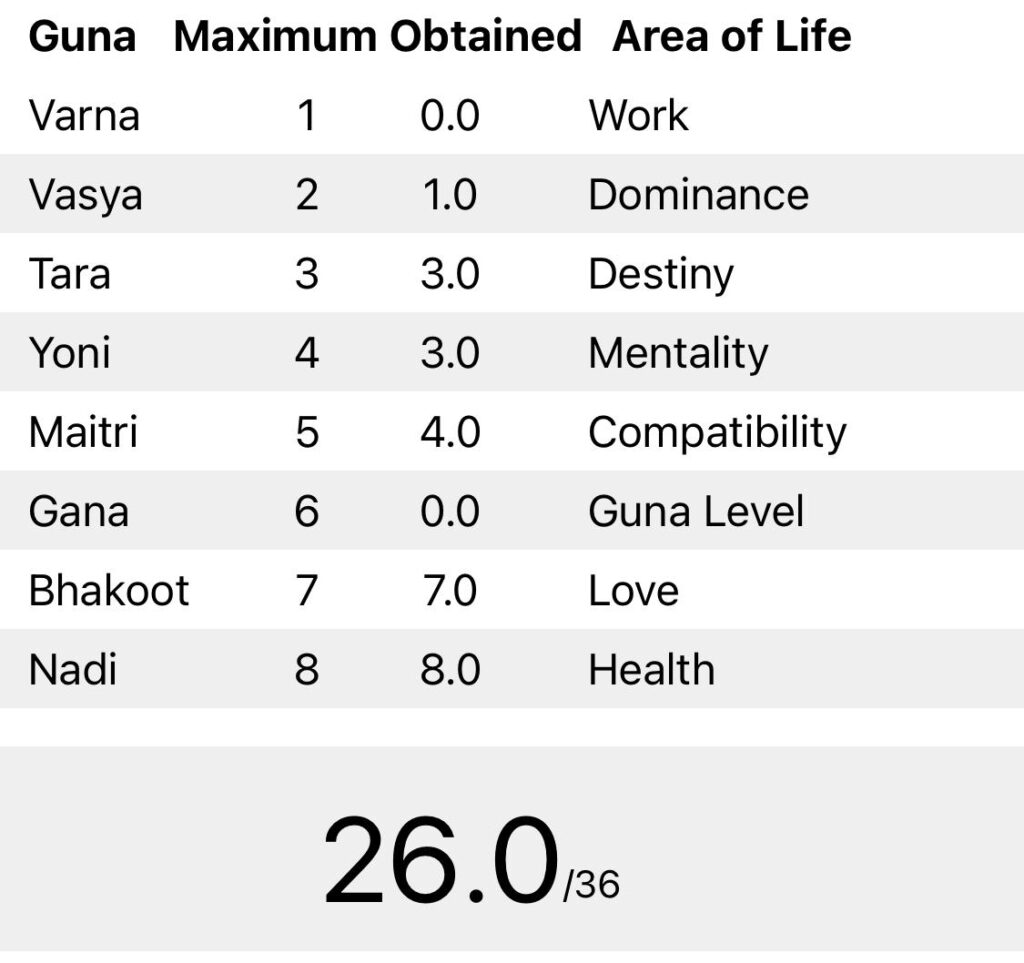
In the above chart, it can be seen that there are three qualities/guna where the points are less. The points for Yoni are 3 out of 4 and that means the mind of the prospective life partner will remain united. Even their intimate life will also be good as the Yoni quality shows a 75% match. The points for Graha Maitri are 4 out of 5 and that means there will be a good level of friendship between partners. But the point for Gana is 0 out of 6 and that means there will be differences in opinions and nature between partners. If they both work on their nature and are inclined towards spirituality, then the match can be considered good. Overall, the points are good but there are only certain areas such as Gana where the points are not appropriate.
On the basis of Ashtakoot Melapak, one can know the qualities where the points are less and can work on those areas to achieve success and happiness in married life. This is the science of Kundli matching. So, whenever the time comes to choose your life partner or any of your close one’s partners, you should always get the kundli matched with the respective partner for marriage. Even if you are already married and have any kind of problems or differences in your married life, then also you can get your Kundli matched and work on the areas where the points are low. By working on the areas having a low number of points, you will surely be able to achieve a better married life. Thus, it is advisable for all to match Kundli with their prospective partners to achieve happiness, peace, and prosperity in married life.
Shubham Bhavatu.









Comment (1)
Puneet Gada
October 21, 2023 at 9:27 amVery well explained